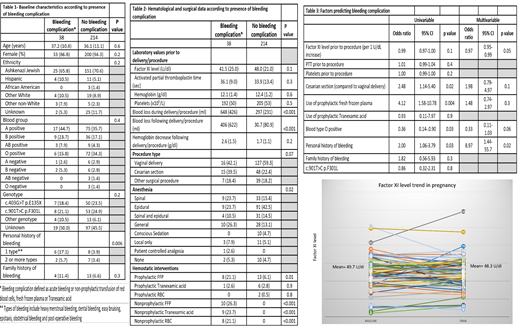Abstract

Introduction
Factor XI deficiency (FXI) is an autosomally inherited injury-related bleeding disorder. Although relatively rare worldwide, it is common amongst Ashkenazi and Iraqi Jewish ancestry with a heterozygosity rate as high as 8 to 9%. FXI deficiency does not provoke spontaneous bleeding; however, it predisposes to a potential risk of life-threatening bleeding at childbirth or surgery. Unfortunately, data regarding obstetrical and perioperative management of this condition is scarce, with less than 500 cases reviewed in the last 20 years. Therefore, this study aimed to expand this database and identify factors associated with increased bleeding risk.
Methods
We performed a retrospective chart review of patients (pts) with FXI deficiency who underwent childbirth or other surgical procedures between August 2011 to April 2021 within the Mount Sinai Health System in New York City. Data on age, sex, ethnicity, genotype, family or personal history of bleeding, type of anesthesia, estimated blood loss, peri-procedural bleeding complication, and type and timing of blood product or hemostatic agent administered in the peri-operative period were collected. Prior history of bleeding was defined as 1 or more of the following: easy bruisability, epistaxis, heavy menstrual bleeding, bleeding related to dental, surgical or obstetrical procedure. The paired t-test was used to compare the initial and subsequent FXI levels measured during pregnancy. We performed logistic regression to test the association between historical, laboratory, and procedural variables with the bleeding endpoint (defined as acute postpartum or postoperative hemorrhage or any bleeding warranting non-prophylactic administration of packed red blood cells, fresh frozen plasma [FFP], or tranexamic acid). Receiver operative characteristic (ROC) curve was plotted for FXI levels to identify the cutoff for optimal sensitivity and specificity. Analyses were performed using SPSS software.
Results
We identified 198 pts who underwent 252 procedures in total- including 143 vaginal deliveries, 64 C-sections and 45 other surgical procedures. Mean age was 36 years with 94% females, and ~70% were Ashkenazi Jews. c.403G>T p.E135X (42%) and c.901T>C p.F301L (44.8%) were the most common genotypes identified. 38 out of 252 procedures resulted in bleeding complications. In multivariable logistic regression, both prior history of bleeding (odds ratio (OR) 8.97, p=0.02) and lower FXI levels ( OR 1.03 per U/dL increase, p=0.05) were independently associated with the bleeding endpoint. Family history of bleeding, ethnicity, genotype, pre-procedural PTT and platelet levels were not associated with bleeding risk. There were no cases of epidural or spinal hematomas associated with neuraxial anesthesia in our cohort. Mean FXI level for pts receiving neuraxial anesthesia was 50 U/dl (3-118 U/dl). Five pts who had a negative bleeding history despite surgical challenges received neuraxial anesthesia at FXI level <10 U/dl without any complications (only 1/5 received prophylactic FFP). Mean FXI level for pts receiving prophylactic FFP was 25.6 U/dl (range 1-71 U/dl). 8 out of 21 (38%) pts suffered a bleeding complication despite prophylactic FFP use. ROC analyzing FXI levels as a risk factor for the bleeding endpoint resulted in an AUC of 0.605 with specificity of 96%, 94%, 91%, 83%, 49% and sensitivity of 11%, 12%, 19%, 35%, 65% respectively for cut-off values of 10, 20, 30, 40 and 50 U/dl. Of note, there was no significant variation in FXI levels during pregnancy [mean first measurement was 49.7 U/dl vs final measurement of 48.3 U/dl, p=0.3].
Conclusions
Personal history of bleeding is the strongest predictor of perioperative or obstetrical bleeding in pts with FXI deficiency. Higher FXI levels correlate with a slightly lower but statistically significant odds of surgical bleeding. Although a FXI level cut-off of 40 U/dl may predict bleeding risk with reasonable specificity (83%), it lacks sensitivity and must be interpreted in the context of personal bleeding history. FXI levels remain stable during pregnancy and repeat measurements may not be necessary. Neuraxial anesthesia appears to be safe to use in this cohort.
No relevant conflicts of interest to declare.
Author notes
 This icon denotes a clinically relevant abstract
This icon denotes a clinically relevant abstract


This feature is available to Subscribers Only
Sign In or Create an Account Close Modal